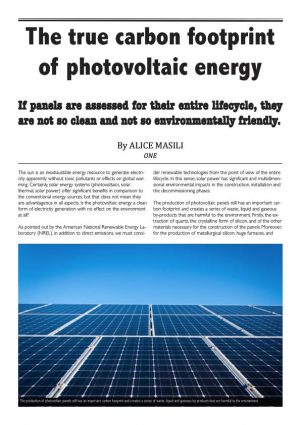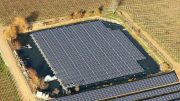 The sun is an inexhaustible energy resource to generate electricity apparently without toxic pollutants or effects on global warming. Certainly, solar energy systems (photovoltaics, solar thermal, solar power) offer significant benefits in comparison to the conventional energy sources, but that does not mean they are advantageous in all aspects. Is the photovoltaic energy a clean form of electricity generation with no effect on the environment at all?
The sun is an inexhaustible energy resource to generate electricity apparently without toxic pollutants or effects on global warming. Certainly, solar energy systems (photovoltaics, solar thermal, solar power) offer significant benefits in comparison to the conventional energy sources, but that does not mean they are advantageous in all aspects. Is the photovoltaic energy a clean form of electricity generation with no effect on the environment at all?
As pointed out by the American National Renewable Energy Laboratory (NREL), in addition to direct emissions, we must consider renewable technologies from the point of view of the entire lifecycle. In this sense, solar power has significant and multidimensional environmental impacts in the construction, installation and the decommissioning phases.
The production of photovoltaic panels still has an important carbon footprint and creates a series of waste, liquid and gaseous by-products that are harmful to the environment. Firstly, the extraction of quartz, the crystalline form of silicon, and of the other materials necessary for the construction of the panels. Moreover, for the production of metallurgical silicon, huge furnaces, and very high temperatures, with the production of large quantities of carbon dioxide and sulphide, are needed.
Furthermore, the chemical process necessary for obtaining the polycrystalline silicon occurs through a reaction with hydrochloric acid and hydrogen, which leads to the formation of a very high by-product, silicon tetrachloride. It is a by-product but, proportionately, for each part of high-purity silicon produced by the reaction, silicon tetrachloride is from three to four times as much. The most advanced technological processes have reduced the production of toxic substances, for example subsequently reprocessing them for the extraction of other high purity silicon at lower costs, decreasing energy required for the extraction of new raw material.
Although western countries are developing technologies that can reduce the environmental impact of this type of production, most of the panels, assembled today in the West, are produced with more antiquate technologies in areas of the planet known to be less attentive in respecting the environment.
In fact, half of the world production of photovoltaic panels takes place in China. In general, it has been estimated that around six months are needed for a solar panel to produce the energy required to clear the carbon dioxide emitted to produce it. However, this aspect depends mostly on the place of production. In China, for example, much of the energy is generated from fossil fuels, mainly coal, so, the carbon footprint of its electricity production is twice that of the United States. Consequently, also taking into account other factors, such as transport and logistics necessary for export, and the fact that China is its largest global producer, when a panel is installed on a European roof it takes about a year to cancel the carbon footprint necessary to produce it. As a result, when the panel produces clean energy in China the production of greenhouse gases increases. This is why solar energy is clean, but not so much. Also recycling faulty panels, or those at the end of their life, leads to environmental problems.
A solar panel lasts 30 years. At the end of its life cycle, it has to be treated as a special waste. Numerous elements compose a PV panel, including toxic substances such as copper, lead, gallium, selenium, indium, cadmium and tellurium. The separation and recovery of these metals is not an easy process. These substances, potentially hazardous to health, are in small percentage compared to the most non-hazardous, such as glass, polymers, and aluminum.
Since photovoltaics is a relatively new product, today we have to face the first phase of development of the photovoltaic recycling industry, which could convert this waste into a resource. It is not difficult to understand that proper recycling is a precious resource for the production of materials in production chains, photovoltaic panels and more. To do this, it is necessary to disassemble the panel and correctly separate the elements that compose it. In addition, the development of a used panel market could also be interesting, especially in developing countries where purchasing power is limited.
Another adverse effect of solar power is associated with land use. To build a utility-scale solar power facility, a large area of land is required. This can interfere with the existing land uses. The use of many acres of land can result in clearing and grading of land, which can cause soil compaction, erosion, and alteration of drainage channels. Furthermore, solar energy systems can affect the area in the process of materials extraction, exploration, manufacturing, and disposal.
The rising demand for energy and the push towards low-carbon energy sources leads to rapid growth of ground-based photovoltaic parks all over the world. This constitutes an important change in land use on a global scale and requires critical studies for a detailed understanding of the impact of solar parks on the ground below them.
A study of researchers from the Centre for Ecology and Hydrology of the University of Lancaster, in Great Britain, published in the journal Environmental Research Letters, describes what happens to the soil and vegetation below the solar panels. After monitoring the plants in the large Swindon solar park for about a year, the scientists noticed that, below the panels, the temperature was on average 5 degrees lower than the rest of the surface. This shading effect causes a change in the climate that can damage the growth of some plants. Solar panels undoubtedly affect the earth, shielding the ground from the sun’s rays. However, according to Dr. Alona Armstrong of Lancaster University, the shade under the panels can allow crops that cannot survive in full sun to be cultivated. In addition, water losses can be reduced and water could be collected from large solar panel surfaces and used for crop irrigation.
Although there are no global warming emissions associated with the generation of electricity from solar energy, there is no doubt that there are emissions associated with other phases of the life cycle of a photovoltaic system, including production, transport of materials, installation, maintenance and dismantling, and disposal. As demonstrated by the scientific literature collected by the NREL of the US Department of Energy, the energy invested to produce a photovoltaic system, including components and installation, ranges from 3 to 13% of what the system will produce in 30 years.
If we compare the energy payback ratio, the relation between energy invested and energy produced, with that of other sources, we see that the photovoltaic has an higher performance than, for example, a coal-fired power plant. With the big difference that, in the case of PV, from 87% to 97% of the energy produced by the plant does not involve any emission or pollution.
Any human activity has what is called anthropogenic impacts. Many of which are extremely positive and some are damageable drawbacks. No human activity is environment-neutral. As always, humans have to develop technologies to fix the environmental issues caused by our inventions. Often our latest “solutions” create or add more damage, even if we initially welcome them as the ultimate answer. It keeps us busy, having to solve a continuing series of (mainly) self-inflicted problems. Unless a complete assessment of all costs (including environmental effects) and benefits is performed, better not to trust anyone glorifying a technology that has not fully analysed this balance.
Alice Masili




